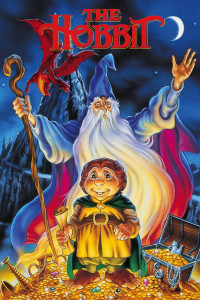 Sarah Meador wrote this review.
Sarah Meador wrote this review.
The animated musical version of The Hobbit, produced for American television by Arthur Rankin, Jr. and Jules Bass (Rankin-Bass), opens with a small bit of narration from the book as the camera pans over lovely background paintings of the Shire and into Bag End. The backgrounds, here and throughout the movie, are truly wonderful: atmospheric ink and water-color paintings in the same style as Tolkien’s illustrations. This makes it even more jarring when Bilbo shows up looking like a tomato with sideburns and furry feet. Extreme exaggeration of features seems to be the rule for all the character designs. Gandalf is all nose and robes, and the dwarves at first come across as beards with eyes. But the style isn’t too extreme to get used to, and a lot of thought obviously went into the character designs. The dwarves are especially impressive, with family connections and temperament showing in each face.
Unfortunately, this artistic enjoyment doesn’t last. After Gandalf convinces Bilbo to go with Thorin and his party to defeat Smaug, there follows the dinner party, and the film shows us its ugly face: excessive singing. Apparently the staff at Rankin-Bass were unsure of how to communicate character interaction and development through dialogue or facial expressions, and chose to do it through songs instead. So the dwarves sing a song about Bilbo’s prissiness. Then Bilbo wakes up in the middle of the night, and some phantom minstrel (Glenn Yarbrough) sings “The Greatest Adventure,” a tune about taking chances that might almost be pleasant if not sung by a warbly voiced minstrel, apparently to subtly let us know that Bilbo has decided to go on an adventure. If you like this song, rejoice! It will reappear throughout the entire movie.
The movie follows the book fairly closely in the journey to Lonely Mountain. All the battles and dangers, from the trolls to the Gollum to the spiders, make their appearance. Somehow, though, the threats fail to threaten. Maybe it’s because there’s not a single combat scene; various individuals make threatening motions with weapons, but no weapon is ever seen to connect. If a foe is injured, they look stunned, show up against a black background, then spiral down a receding path into that background. Or perhaps they’re not injured, as some foes (the giant spiders, some goblins) are then seen fighting as energetically as ever the next moment. Battle is less threatening when the worst that can happen to someone is a moment of surprise. Or it could be the appearance of the enemies; the goblins look like vaguely unpleasant versions of Frog and Toad from the childrens’ books, and Gollum looks like a cross between a frog and an egg. It’s hard to imagine these bloated amphibians hurting anyone. But I think the real blame for the emotion-free nature of the journey goes to the acting and the music. Nobody acts, they just exposit, announcing to the camera that There Is Trouble. And that’s about all they do announce; subtler moments receive no dialogue, just a close-up of Bilbo’s face while a line or two of “The Greatest Adventure” plays. The lines get played in order, with no particular sense of appropriateness to the story, and considerably sap any building sense of excitement.
It’s not until Gandalf leaves the party after the goblin attack that things really get bad. Bilbo is left to keep a log of the party’s adventures, and the script uses this as an excuse for some really hefty narration. Actual dialogue all but disappears as Bilbo narrates his way through the Elf caves, down the river, and into Dale, his musings only being interrupted by a drinking song, and a song about Brave Mr. Baggins, and “Roads Go Ever On and On” set to music.
The most disappointing thing about Rankin-Bass’ The Hobbit is that it didn’t have to be disappointing. The animation is fluid and lively, the character designs are expressive, and the backgrounds are a joy. The movie even holds true to the book in its shoreline. The only elements that don’t work at all are the soundtrack and script, but they manage to sink the entire thing. If you really want to enjoy this version of The Hobbit, turn it on, hit the Mute button, and play some nice atmospheric instrumental music over it. As a movie, it makes a good set of illustrations.
(Rankin-Bass/NBC, 1977; DVD Warner Brothers, 2001)
